
My husband and I have had the privilege of spending two summers touring the island of Newfoundland in our travel trailer. We were there for two months in 2007 and three months in 2019.
While exploring the back roads of the Bonavista peninsula on our more recent trip, we came across this rusty gas pump on its concrete pad, smack in the middle of a field of grass, in the tiny settlement known as Red Cliff.
The price on the pump was 75 cents a gallon, so it probably made its last sale in the 1970’s, before the metric system was adopted in Canada. Any surrounding buildings were long gone. On the shore beyond, a row of houses and fishing sheds had succumbed to wind and rain.

I could imagine a story here about the families who lived and worked in this beautiful place. I knew this would make an exciting painting subject and took lots of photos.
Back at home the following winter, I got to work on a watercolour interpretation of this scene, beginning with a pencil drawing on 300 lb cold press watercolour paper.

I used Sennelier watercolour paints which are made in France and I was very impressed with their clarity and strength of colour.
The three pigments I chose (Sennelier Red, Sennelier Yellow Deep, and Phthalocyanine Blue) worked perfectly for mixing every colour needed in this painting.
First I painted blue on the sky and water, working wet in wet and avoiding the row of houses in the background.
The grass was finicky to paint, using many layers of masking fluid and paint to achieve the effect of individual blades of grass. This part of the scene took the longest to paint.

I began by protecting the body of the gas pump with masking tape, and the fence posts and blades of grass in the foreground with masking fluid.
Once that dried, I painted in the first layers of the grass field and the concrete pad, working on wet paper to create soft transitions of colour.
After the first grass layer dried, I masked out more blades of grass over the existing paint, let that dry, added another layer of green paint, and let that dry.

Repeating this process a few times gradually built up grass blades of differing values, and this variety is what makes watercolour grass look real.
After removing the masking, I deepened the blue colour of the ocean, making sure to keep the horizon line absolutely straight and level.
I added colour to the white blades of grass that had been under the first layer of masking fluid, and painted in the shadows of stony details on the concrete pad.

The rusty gas pump was an absolute joy to portray in watercolour and very easy to do, compared to the grassy field.
Having well-focused reference photos of the pump from every angle, and up close, was key to recreating this relic in a realistic manner.
I worked on dry paper using a two-brush technique. One brush was loaded with colour and one held only clear water. I laid down paint in the shape I wanted, and then used the clear brush to subtly blur or soften the edges, to bleed out the colour where needed. This was very effective in portraying streaks of rust.
The same two-brush technique was used on the black rubber hose on the pump, creating the soft grey highlight that produced the look of a cylinder.

I used a magnifying glass and super fine Micron pens with archival ink to do the lettering on the pump.
The final step was to paint the dilapidated houses and fishing sheds on the seashore in the distance.
Again, I had taken excellent reference shots of the buildings when we were there, and used the photos extensively to portray these rustic structures accurately.

I love the atmospheric feeling of this scene. It brings to mind stories of the glory days, when this was a thriving little settlement full of energetic families, with a glorious view of the sea.
In this photo, I am holding the finished painting in my art studio. In front of me, you can see the three tubes of paint I worked with as well as the #12 round sable/synthetic brushes I used to paint this artwork.
I titled the painting, 'Yesterday's Dreams', (varnished watercolour on 14 x 11 inch panel), paying homage to the families who called this place home during the last 250 years. A collector acquired my painting a few months later.
Although the original has found its forever home, art prints of Yesterday's Dreams are available from my publisher FineArtAmerica, a world-renowned print-on-demand company. This image can be enjoyed on canvas, paper, wood, acrylic, or metal prints, or featured on other fine products. Click here to see the 'Yesterday's Dreams' selection on my FineArtAmerica web page.
Newfoundland remains one of my favourite Canadian destinations, featuring the hospitable, fun-loving, hard-working inhabitants, their wondrous musical abilities, and world-famous natural attractions such as Gros Morne National Park and Western Brook Pond.

We also greatly enjoyed the historic Viking settlement re-enactment at l'Anse aux Meadows, numerous iceburg-sightings, a vast array of lovely wild flowers, and learning the history of the cod fishery at Twillingate.
The Skerwink cliff trail and historic architecture at Trinity, magnificent sea views at Bonavista, berry picking on the Avalon, and the vibrant culture and architecture of St. John's all were wonderful experiences.
I believe every Canadian should visit the island of Newfoundland, given the chance. If you need persuading, check out the adventure highlights of our most recent trip in my other posts: 'Icebergs of Newfoundland', 'Top 14 Vistas of Newfoundland', 'A Whale of a Tale in Newfoundland', and 'Seeing Caribou and Moose in Newfoundland'.
If you have comments you wish to share, please do so using the 'Leave a Comment' button at the top of this post.
Subscribe to Karen's Newsletter for exclusive early access to new work, studio news updates, travel tales, painting tips, and notices of upcoming exhibitions.






 The most difficult part of this scene, believe it or not, was the forest. I knew I had to get that right before I invested weeks and weeks into painting stones.
The most difficult part of this scene, believe it or not, was the forest. I knew I had to get that right before I invested weeks and weeks into painting stones.






 If you are like me, whenever this time of year rolls around I yearn to see fresh colour.
If you are like me, whenever this time of year rolls around I yearn to see fresh colour.




 If you have not visited The
If you have not visited The 

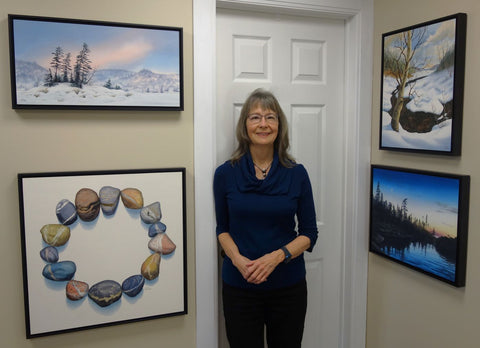

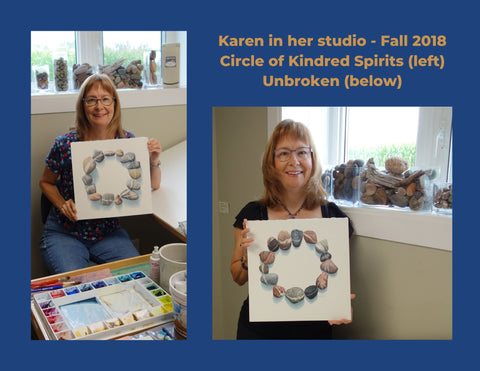

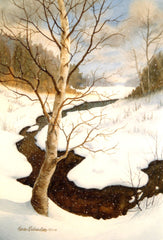
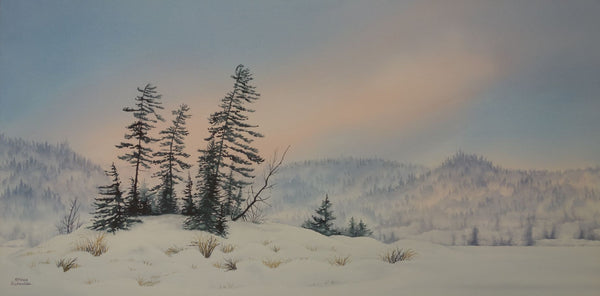
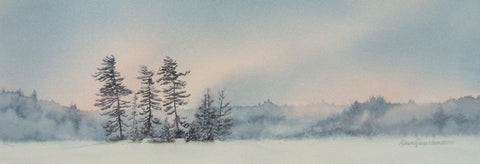

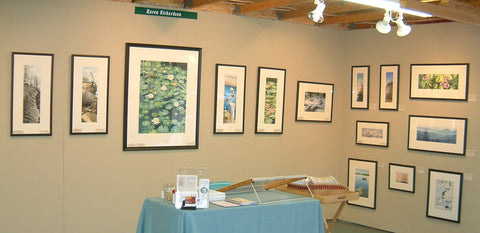 This is a photo of my booth at the 2006 Buckhorn Fine Art Festival, where Enchantment was sold to a collector. It is the tiny painting in the middle of the far right wall. In those days, I was framing my watercolours with mats and glass. Now I mount them on art boards and varnish with a UV blocking coating, eliminating the need for glass. You can read about my framing process in this article:
This is a photo of my booth at the 2006 Buckhorn Fine Art Festival, where Enchantment was sold to a collector. It is the tiny painting in the middle of the far right wall. In those days, I was framing my watercolours with mats and glass. Now I mount them on art boards and varnish with a UV blocking coating, eliminating the need for glass. You can read about my framing process in this article: 
 This is the third time I have painted this scene, and it resonates so powerfully with me, I feel like I could paint it again sometime in the future. This artwork celebrates all I hold dear about northern scenery: vast skies, clear blue water, smooth stones, and hardy pine and spruce trees.
This is the third time I have painted this scene, and it resonates so powerfully with me, I feel like I could paint it again sometime in the future. This artwork celebrates all I hold dear about northern scenery: vast skies, clear blue water, smooth stones, and hardy pine and spruce trees.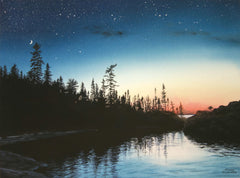
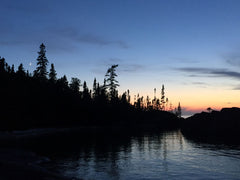 She was on a back country camping trip and her party stayed overnight in tents on this beach. She graciously granted me permission to use her stunning sunset photo (shown left) as reference for my artwork.
She was on a back country camping trip and her party stayed overnight in tents on this beach. She graciously granted me permission to use her stunning sunset photo (shown left) as reference for my artwork. In my last post, I told the
In my last post, I told the  My photo of a tree growing from a rocky cliff was taken on the Port au Port peninsula near Stephenville, and my photo of large boulders was from Gros Morne National Park.
My photo of a tree growing from a rocky cliff was taken on the Port au Port peninsula near Stephenville, and my photo of large boulders was from Gros Morne National Park.































